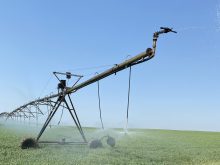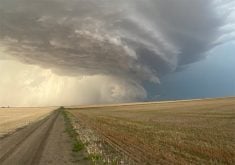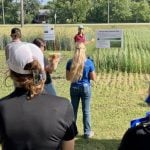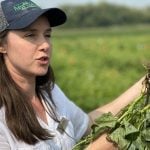OKOTOKS, Alta. – Yvonne Tollens’s name may be the one on the awards received by her computer company, but she says the recognition belongs to her staff of 10 who are encouraged to eavesdrop on each other, chatter and share ideas for innovative solutions for clients.
“We’ve got a whole group of people who knows how to think,” she said from her office at Okotoks where she and her husband, Ralph Tollens, run ComputerAid Professional Services. The 20-year-old company develops computerized databases and business solutions for the cattle industry.
Read Also

Rented farmland jumps 3.4 million acres in Saskatchewan and Alberta
Farmland rented or leased in the two provinces went from 25.7 million acres in 2011 to 29.1 million in 2021, says Census of Agriculture data.
This summer Yvonne was named one of Alberta’s 50 most influential leaders and an Ag Patch Innovator by the business magazine, Alberta Venture.
Each year more than $1.5 billion worth of cattle and commodity inventory are managed on software developed by the Tollenses’ company.
“If you can run your business, I can teach you to run a computer,” said Yvonne.
She has become a policy analyst with business savvy who follows agricultural issues such as how BSE affected export rules, changes to the Canadian Wheat Board and the potential fallout of country-of-origin labelling for meat.
When the United States border opened to live cattle in July 2005 after two years of trade bans, the company had a computerized export program ready a week later to ease the burden of records and paperwork for clients. The Tollens helped export about 200,000 cattle to the U.S. because they could capture data needed for documentation and obtain Canadian Food Inspection Agency signoff.
“ComputerAid is the only software company that went to those (BSE information) meetings to learn what was required,” said Ralph.
Born and raised on a Nicola Valley cow-calf operation in the interior of British Columbia, Yvonne earned a business degree and eventually ended up in Calgary’s oil and gas business where she met her husband, a computer analyst.
She spoke agriculture and he talked computers.
Together they developed a computer consulting business after they learned there were no all encompassing programs to deal with the complexities of the livestock industry in North America. They developed their own, beginning with a cow-calf records management program.
“A lot of the stuff we do has never been done before,” she said.
When they started, computers did not give cattle producers what they needed.
“At that point in time the computer world was still in its infancy. There weren’t a lot of people we could turn to for support in our computers and more importantly how you could use them to create a solution for a problem,” Ralph said.
They started with cow-calf management programs called Ranchers Advantage and around 1994-95 they started building large databases and software for feedlots, which led to Cattle Bytes.
Today, most of their work is with feedlots across Western Canada, Kansas and Oklahoma.
“Data collection management systems were not a big thing for that time for calf producers so we evolved into the feedlot sector,” said Ralph.
The system can track the source of the cattle, arrival dates, weight, feed consumption, inventory and health records on individuals if required.
The company has worked with the Canadian Cattle Identification Agency on the age verification program and its record programs can dovetail into requirements for on-farm food safety.
When BSE was found in Canada in 2003, the problem of poor records was evident. If the animals had been within ComputerAid managed systems, information could have been tracked within a few hours.
“We keep track of every single day. We know exactly what the inventory was on that day. For every one of our clients they could go back and give an accurate accounting,” Yvonne said.
During the summer of 2003 when cattle markets collapsed, the data management system was used to make better marketing decisions so high cost animals could be sold off sooner and inventory would indicate what should be moved and when to capture the limited dollars on offer.
Their program can also work for people practising retained ownership. It can track commodity markets that may give a signal on when to sell.
The first step when someone approaches the business for help is to talk about what is needed. Potential clients are given an internet-based demonstration and software can be modified to a specific operation.
The client can choose between software for feedlots, cow-calf, animal health, age verification, export cattle investment systems, individual animal management and custom solutions.
For most agricultural companies, ComputerAid becomes an information technology division.
“At one time farmers could work on their own vehicles but in the cars it became more difficult to do that. Computers are a lot like that and we have evolved a long way from the Window 95 machine,” said Ralph.
Systems change about every four years. He compares it to a child that grows and changes.
“Software only has a start. It doesn’t end.”
When someone decides to use their services, the Tollens do all the heavy lifting of transferring records and other data, and provide a professional personal computer workstation.
They provide training and company staff is available to answer questions on software and hardware.
“Ralph is able to bring out the key elements and make that translation between the business and the person who is the programmer,” Yvonne said.
It remains a challenge to deliver programs via the internet since many rural operators are still using dial-up. Wireless connections are not perfect either, especially during peak periods of use.
From Yvonne’s perspective, there should be improved access to the internet in rural communities along the same lines as rural electrification or telephone programs.
Improvements are coming.
In Alberta, public buildings are part of the provincial SuperNet system, although that may not be convenient for someone at home on the farm. However, it does allow wireless providers to join the system and more feedlot clients have joined the broadband system, said Ralph.
“That is becoming significantly more available in Alberta than it was four years ago.”















